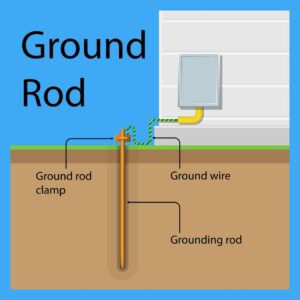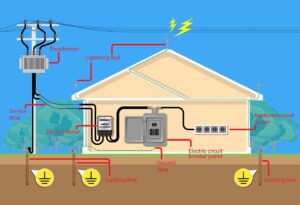What is the difference between earthing and lightning arresters?
Earthing and Lightning Arresters
When it comes to safeguarding electrical systems (including solar PV systems), understanding the concepts of earthing and lightning arresters is crucial. Both play pivotal roles in protecting equipment and ensuring safety, but they serve distinct functions. In this article, we’ll delve into these essential components, shedding light on how they contribute to electrical safety.
Earthing, often referred to as grounding, is a fundamental safety measure that connects the electrical system to the ground for stability and safety. This connection helps prevent electrical shocks and equipment damage by providing a direct path for fault current to flow into the earth. Thus, any excess electricity, like short circuits or overloads, is efficiently discharged, keeping users and appliances safe.
On the other hand, lightning arresters serve as a first line of defense against the destructive force of lightning strikes. These devices are designed to protect electrical systems by intercepting and directing lightning’s high voltage into the ground, rather than allowing it to pass through the building’s wiring. By doing so, lightning arresters help prevent fires, equipment damage, and potential safety hazards that a lightning strike could cause.
In summary, while both earthing and lightning arresters are essential for maintaining electrical safety, they are designed to handle different risks. Earthing primarily deals with everyday electrical fault conditions, while lightning arresters specifically protect against the potent surges caused by lightning. Understanding their distinct roles ensures that you can implement the right protection measures for your home or business, ensuring safety and longevity for all connected devices.
Electrical safety systems are crucial for protecting both human life and valuable equipment. Understanding their importance can prevent serious accidents and financial loss. Two of the most essential components in electrical safety are earthing and lightning arresters. While they serve different functions, they both work to minimize the risk of electrical hazards.
Electricity is an integral part of modern life, but it can be dangerous if not properly managed. Faulty systems can lead to electric shocks, fires, and equipment damage. That’s where earthing and lightning arresters come in. They provide a path for uncontrolled electrical energy, significantly reducing the risk of damage or injury.
Earthing, also known as grounding, is designed to protect people from electric shock. It ensures that any fault current is safely directed into the ground instead of passing through a human body. On the other hand, lightning arresters protect buildings and electrical apparatus from the dangerous surges caused by lightning strikes.
Both systems work in tandem to enhance safety. Earthing ensures everyday safety by stabilizing voltage levels and preventing electrical shock, while lightning arresters provide protection from the high-voltage transients caused by lightning. Together, they form a comprehensive safety net.
Investing in proper electrical safety systems is not just about compliance but also about safeguarding lives and property. Understanding their roles and functions can help you make informed decisions about protecting your environment against electrical hazards.

Earthing is a crucial component in electrical systems that ensures the safety and stability of both residential and commercial buildings. Also known as grounding, earthing involves creating a direct physical connection between electrical systems and the Earth itself. This connection is achieved by using conductors to link electrical installations to the ground, providing a safe and efficient path for excess electricity to dissipate into the Earth.
The primary purpose of earthing is to protect people and equipment from electrical faults and surges. When an electrical fault occurs, such as a short circuit, earthing offers a low-resistance path for stray currents to flow safely into the ground, preventing possible electrical shock or fire hazards. By maintaining a reference voltage at zero potential, earthing helps stabilize voltage levels in the electrical system, enhancing performance and reliability.
In addition to safety, earthing also plays a vital role in enhancing the overall efficiency of electrical installations. Proper grounding can minimize the risk of damage to sensitive electronic equipment, reduce electromagnetic interference, and ensure the smooth operation of electrical appliances.
For homeowners and businesses, implementing effective earthing practices is essential for safeguarding lives and property. It provides peace of mind knowing that the electrical system is built to withstand unexpected electrical disturbances. Understanding earthing’s importance highlights the need to work with qualified professionals to ensure that ground connections are properly designed and installed to meet safety standards.
What is a Lightning Arrester?
A lightning arrester is a critical component in electrical systems, designed specifically to protect structures and electrical equipment from lightning-induced surges. When a lightning strike occurs, it can release a massive amount of electrical energy that, if not properly managed, can cause severe damage to electrical devices, appliances, and even entire buildings. This is where a lightning arrester comes into play.

Installed at strategic points, usually near or on the equipment it protects, a lightning arrester acts as a first line of defense. It consists of a combination of conductive elements that channel the excess voltage away from the system and into the ground. In essence, a lightning arrester provides a safe path for the high-voltage current, directing it away from sensitive equipment and reducing the risk of fire or electrical shock.
Unlike earthing systems, which provide ongoing stability for electrical systems, lightning arresters are activated only when there’s a surge—like a silent sentinel waiting to spring into action during a storm. Different types of lightning arresters exist, varying in design and capacity to handle different voltages, ensuring there’s an appropriate solution for every setting—from residential homes to industrial complexes.
Choosing the right lightning arrester is crucial for effective protection, as it ensures the safety and reliability of your electrical systems in the face of nature’s unpredictability.
Key Differences Between Earthing and Lightning Arresters
Understanding the distinction between earthing and lightning arresters is crucial for ensuring electrical safety in any infrastructure. While both systems play vital roles in protecting buildings and electrical equipment, they serve very different purposes.
Earthing is a method where electrical charges are safely discharged into the ground. It involves the creation of a low-resistance path for electrical currents, preventing accumulation of excess voltage and thereby averting potential hazards. Earthing is essential for protecting both human life and electrical devices from shocks and electrical fires. It ensures that any fault current is diverted, maintaining stable voltage levels and mitigating damage.
On the other hand, a lightning arrester serves as a shield against the high-voltage surges caused by lightning strikes. Positioned on structures such as poles and transmission lines, lightning arresters provide a specified path for lightning currents to travel safely to the ground. When lightning strikes, the arrester activates, directing the surge away from critical components to prevent outages and equipment damage.
In essence, while earthing is a preventive measure, maintaining safety under normal and fault conditions, a lightning arrester is a protective device specifically designed to handle extreme conditions during thunderstorms. Together, they create a comprehensive safety net for electrical systems, but it’s essential to realize their individual roles and functionalities. Incorporating both can significantly enhance the resilience of electrical installations, safeguarding both infrastructure and lives.
Choosing the Right Protection for Your Needs
When it comes to safeguarding electrical systems, choosing between earthing and lightning arresters—or understanding when you need both—is critical. Each serves a unique purpose in protecting against electrical hazards, and knowing their distinctions can help you make informed decisions.
Earthing is essential for everyday electrical safety in homes and commercial spaces. It efficiently dissipates excess electricity from appliances and wiring into the ground, thus preventing electrical shocks and minimizing the risk of fire. It is crucial for both human safety and the protection of electrical equipment. Regular maintenance ensures that the earthing system stays effective over time.
On the other hand, lightning arresters are vital for protecting buildings and structures from lightning strikes. These devices serve as a first line of defense by intercepting the high voltage from strikes and safely redirecting it into the earth. This prevents direct damage to structures and potential electrical surges that can harm sensitive equipment.
Both systems are complementary, and often, a robust protection strategy involves integrating both earthing and lightning arresters. For instance, while lightning arresters handle the immediate danger of a lightning strike, earthing continuously maintains low-level protection against power surges and electrical faults.
Assess your specific needs based on your environment, local weather patterns, and the sensitivity of your equipment. Consult with electrical safety experts to design a system that ensures optimal protection and peace of mind. Remember, investing in the right protective setups today can save substantial costs and safeguard lives in the future.

What could be causing your electrical distribution board to trip? Read our recent article to find out…
